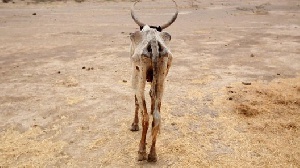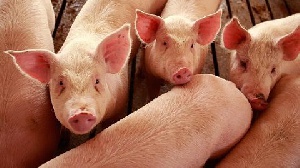The widespread rain received across the country over the past few weeks might have come a little too late for thousands of the country's drought-stricken farmers.
The latest Agricultural Inputs and Household Food Security Situation report places the number of livestock that succumbed to drought at more than 90 000 since October 2018.
The report, released last months, indicates that 88 219 animals died between October 2018 and September 2019, with an average of 7 350 deaths per month.
The latest figures, which will include October to December 2019, are, however, not yet available, Selma Ingula, Agro Business Analyst at the Ministry of Agriculture, Water and Forestry's planning and statistics division told The Namibian yesterday.
According to the report, over 56% (49 235) of the deaths reported are cattle, followed by goats (31% or 27 101), sheep (12,3% or 10 845), donkeys (715) and horses (323), which recorded less than 1% each.
In Omaheke, the situation was noted to be worse, with only a few spots of fair grazing in some areas. In Kunene, //Kharas, Hardap, Erongo, Khomas, Otjozondjupa, Omusati, Oshana, Ohangwena and Oshikoto regions, grazing was described as "very critical" ranging between very poor and bare ground, with high livestock mortalities and some farmers reported to have lost all their livestock.
Concerning cattle mortalities, Erongo was hardest hit, with over 10 000 animals dying. This region also lost the most donkeys (246) and horses (103). //Kharas lost the most goats, with over 14 000 mortalities, while the most sheep were lost in the Kunene region at 4 357 animals.
While trying to receive information from the Namibian Agricultural Union for independent figures of drought mortalities, it was understood that the union does not have such figures, although members of the union were not too sure about the accuracy of the statistics presented by the ministry.
The Meat Board of Namibia's trade and marketing manager, Goliath Tuendjapi, believes the figure might even exceed 100 000 livestock. The reason for the discrepancy, according to him, is that not all farmers report every loss of animals onto the livestock identification and traceability system (Namlits).
He said although the meat board does not keep a record of mortality figures, estimated livestock populations are recorded with regional constituencies, while figures can also be estimated from exports and meat production figures.
Tuendjapi said, over the past five years, Namibia has lost about 50% of its livestock to drought.
"This is a tall order for the Namibian meat industry," he said.
According to him, while animals flood the meat market during periods of drought, the period just after a drought is difficult for the market, as farmers try to restock on animals, which results in price hikes for both the meat producer and consumer.
According to the agriculture ministry's report, grazing conditions have been deteriorating severely throughout the country and poor rainfall performance is said to have worsened the situation. Consequently, many farmers have lost their livestock as a result of the lack of grazing and water. Karibib farmer Cashbox van Wyk said there is no grazing anywhere, and there is no rain.
"Animals are dying every day. We are just hoping for now," he said, adding the figures reported could be much higher because not all farmers report their losses.
Tinus Pretorius, a farmer from Otjiwarongo and a member of the Otjiwarongo Farmers' Forum said the past year was "very bad", and that he alone lost 8% of his animals, and spent a lot of money feeding the cattle through the drought.
"We are receiving rain now, and we are seeing green [grass] which we are not used to anymore. We are looking forward to a positive year although I am well aware of fellow-farmers across the country that are still suffering because of the drought; we are just blessed at the moment," he said.
He agreed that the mortality figures in the report could be much higher as only those farmers who seek compensation will report their losses - and these were mostly communal farmers.
Mini /Uiseb, a communal farmer at Daures, said he was forced to sell all his animals - about 100 cattle, because of the drought.
"It was too harsh. We could not survive. There was no more food or water for them; we had no option," he told this newspaper yesterday.
According to him, there have been some good rains lately, which encouraged the farmers to be optimistic.
"But now there are no more animals in Erongo. We are positive, but we will have to start from scratch," he said.
Africa News of Thursday, 9 January 2020
Source: allafrica.com

















